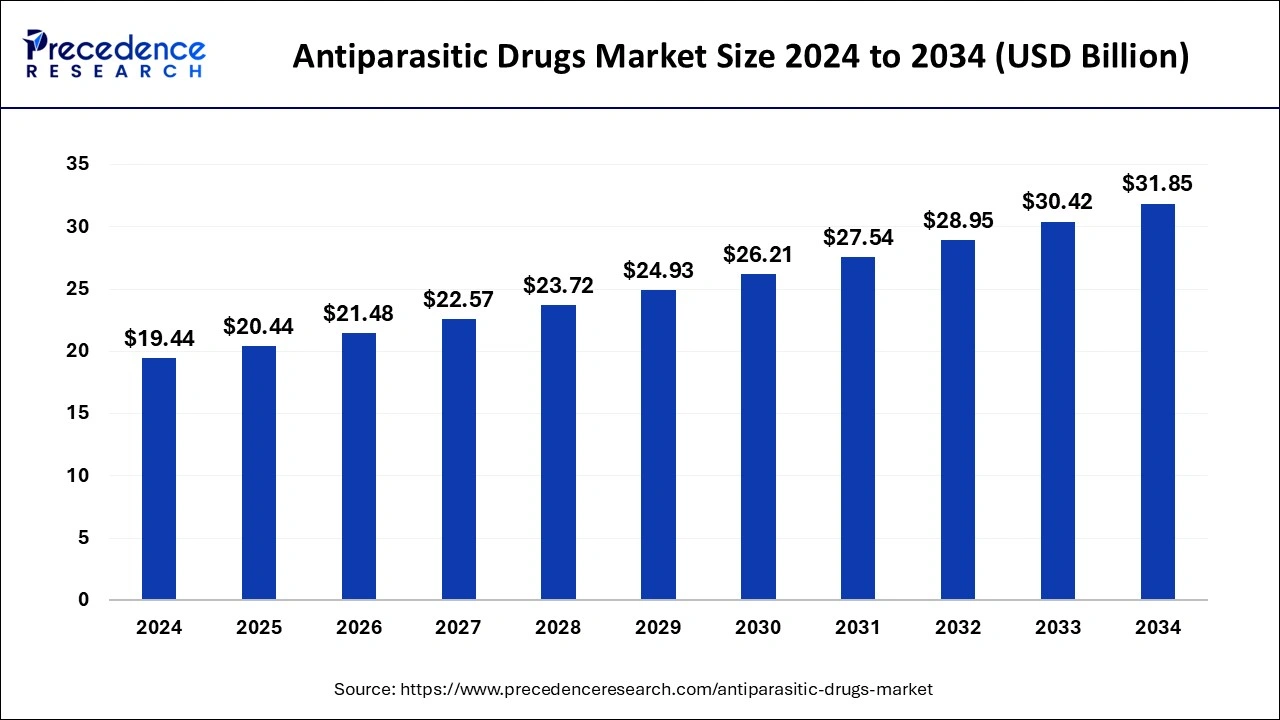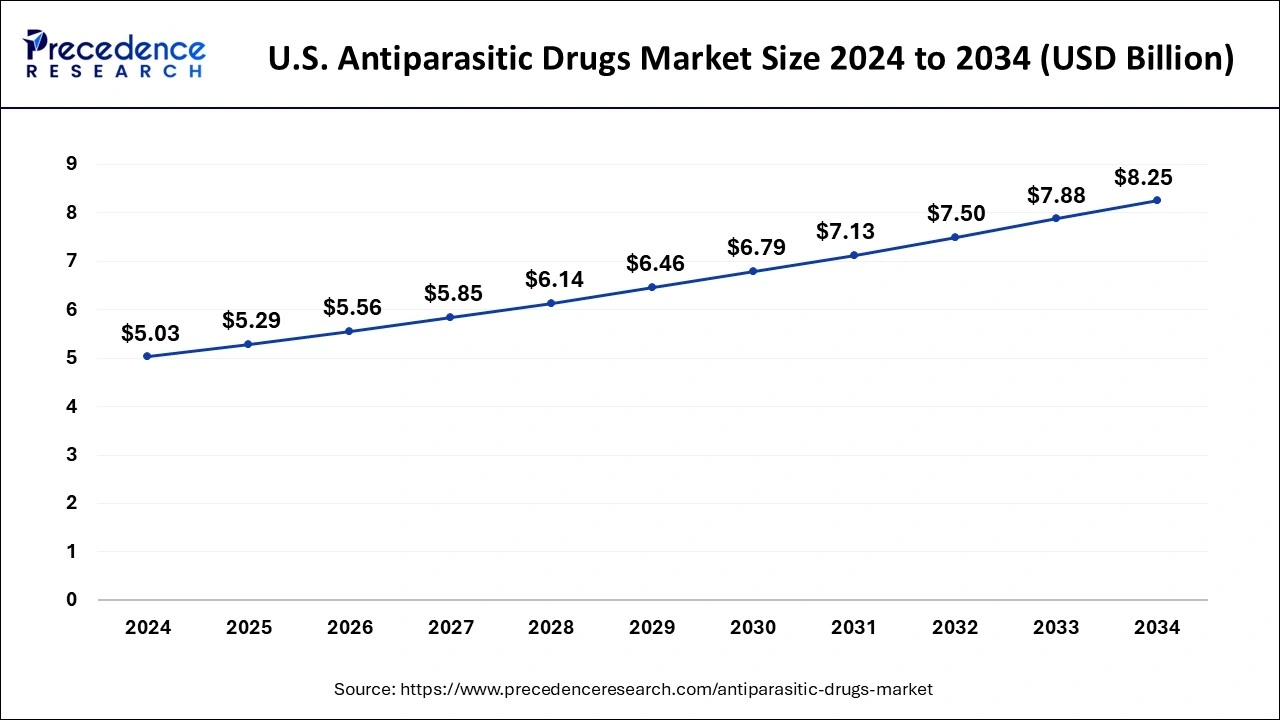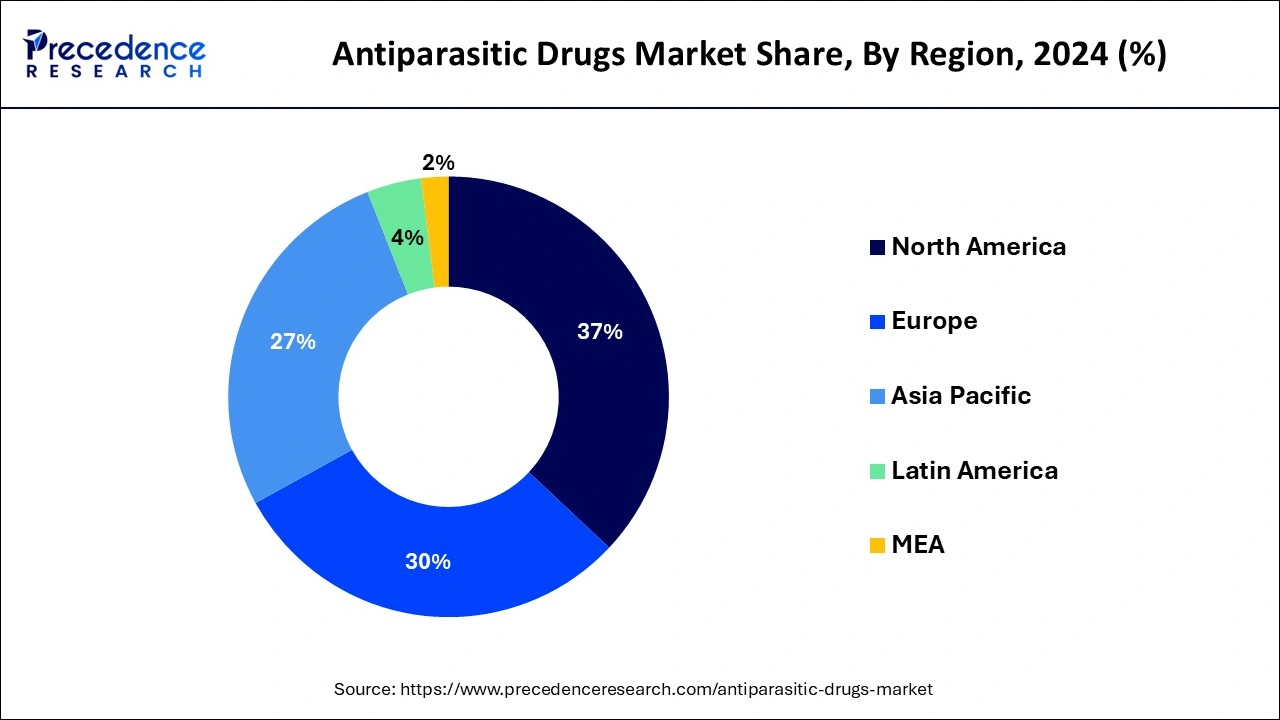January 2025
The global antiparasitic drugs market size is estimated at USD 20.44 billion in 2025 and is forecasted to reach around USD 31.85 billion by 2034, accelerating at a CAGR of 5.06% from 2025 to 2034. The North America antiparasitic drugs market size surpassed USD 7.19 billion in 2024 and is expanding at a CAGR of 5.07% during the forecast period. The market sizing and forecasts are revenue-based (USD Million/Billion), with 2024 as the base year.
The global antiparasitic drugs market size was estimated at USD 19.44 billion in 2024 and is predicted to increase from USD 20.44 billion in 2025 to approximately USD 31.85 billion by 2034, expanding at a CAGR of 5.06% from 2025 to 2034. The increasing cases of parasite infections such as malaria, toxoplasmosis, etc002E, by the environment, impaired quality of water, bug bites, etc., are driving the growth of the antiparasitic drugs market.

The U.S. antiparasitic drugs market size was valued at USD 5.03 billion in 2024 and is anticipated to reach around USD 8.25 billion by 2034, poised to grow at a CAGR of 5.09% from 2025 to 2034.

North America dominated the antiparasitic drugs market with the largest market share of 37% in 2024. The growth of the market is owing to the rising awareness about health among the people, and the rising healthcare infrastructure is boosting the growth of the market. The increasing investments in the development of healthcare infrastructure and the well-established pharmaceutical industry are accelerating the growth of the antiparasitic drugs market. The increasing R&D and the launch of innovative videos are driving the demand for the market.

Asia Pacific is expected to witness significant growth in the antiparasitic drugs market during the forecast period. The growth of the market is owing to the developing healthcare infrastructure and the pharmaceutical industries in countries like China, India, and Japan, which are boosting the growth of the market. The ongoing technological development in the pharmaceutical industry and the launch of innovative medicines are boosting the growth of the antiparasitic drugs market in the region.
The antiparasitic drugs market offers therapeutics that are prescribed to treat infections caused by parasites. The microscopic creatures known as parasites, which reside on or inside humans and animals, cause many illnesses. Antiparasitic medications come in a wide variety. Every medicine specifically targets a parasite. The illnesses they treat can have mild to severe symptoms. Throughout the world, parasites are the source of billions of infections. Parasitic infections come in a variety of forms. Malaria is among the most widespread parasite illnesses. Periodically, gastroenteritis (stomach flu) can be brought on by parasites.
The global expansion of parasitic illnesses has been attributed to greater migration and international travel. The antiparasitic medicine industry is expected to benefit from expanding R&D activity as well as an increase in company collaborations aimed at the growth of the market during the forecast period.
| Report Coverage | Details |
| Growth Rate from 2025 to 2034 | CAGR of 5.06% |
| Market Size in 2024 | USD 19.44 Billion |
| Market Size by 2034 | USD 31.85 Billion |
| Largest Market | North America |
| Base Year | 2024 |
| Forecast Period | 2025 to 2034 |
| Segments Covered | By Drug Type, By Route of Administration, and By Distribution Channel |
| Regions Covered | North America, Europe, Asia-Pacific, Latin America, and Middle East & Africa |
Increasing parasitic infection
The ongoing spread of parasitic infections due to viral disease transmission, environment, contaminated food, bug bites, water, eating undercooked food, etc., has caused a substantial demand for therapeutic solutions. The parasite infection causes fatigue, fever, skin rashes, itchiness, intestinal symptoms, and neurological symptoms. Malaria, toxoplasmosis, head ice, giardiasis, and pinworms are the most common parasite infections that can be found in the human body. Each parasite infection has a different kind of treatment and dosage. Antiparasitic drugs work by limiting the growth of parasites and killing parasites or their eggs. Thus, the rising environmental changes, eating habits, and other reasons for the spread of infections are driving the demand for the antiparasitic drugs market.
Regulatory policies and side effects associated with drug use
Regulatory policies exercise restrictive control on the antiparasitic drugs market. They influence several aspects of the drug development process. The rigid approval process mandated by regulatory bodies retard the product development and manufacturing process dockets while simultaneously adding to the retail prices, generating intimidating barricades to market entry. Another aspect of market retardation is a lack of awareness of antiparasitic drugs in rural and underdeveloped economies, and the side effects of the drugs, in some cases, are limiting the growth of the antiparasitic drugs market.
Increasing research and development
The rising investments by the government, research centers, pharmaceutical firms, and private investors in the research and development program for the development of antiparasitic drugs are driving the opportunity for the growth of the market. Increasing collaboration with the major market firms for the development of the medical drugs market is anticipated to drive the growth of the antiparasitic drugs market.
The anthelmintic drug segment dominated the antiparasitic drugs market in 2024. The growth of the segment is attributed to the rising infection of the helminthic in low and medium-income countries, boosting the demand for the segment in the anthelmintic drug market. The helminths are divided into three groups- cestodes, nematodes, and trematodes, which are also known as tapeworms, roundworms, and flukes respectively. Helmintics differ from infectious organisms. There are various drugs used for the treatment of worm infections. Most of the drugs are administered orally and used in both human and veterinary medicines. The increasing cases of helminth in low- and middle-income countries are driving the demand for anthelmintic drugs in the market.
The antiprotozoal drug segment is expected to grow at the fastest rate in the market during the forecast period. The rising cases of protozoal infection and diseases like malaria, toxoplasmosis, and leishmaniasis drive the demand for the segment in the market. Antiprotozoal drugs are strictly prescription medicines and can be available in various forms of dosage like capsules and tablets, and also available in the forms of powder for prepared as an injectable solution.
The injectable segment projected higher growth in the market in 2024. The growth of the segment is attributed to the higher efficiency of drugs due to the administration of drugs via injections, which is driving the growth of the segment in the market. Injectable administration directly allows the drug to be delivered to the bloodstream and shows the rapid results of the drug. Injectable administration is a direct fight against the infection-causing bacteria in the body due to its direct administration of drugs into the bloodstream. Thus, all these factors are driving the growth of the segment in the market.
The topical segment is expected to grow in the market during the anticipated period. The topical administration of drugs means the medicines are directly applied to the infected skin or hair. Most of the parasites are impacted by the infection on the skin, causing rashes and itchiness. Thus, topical administration is given relief in such kinds of conditions. All these factors are boosting the growth of the segment in the antiparasitic drugs market.
The hospital pharmacies segment dominated the antiparasitic drugs market in 2024. The growth of the segment is attributed to the rising availability of medical professionals, infrastructure, and the handling of injectables administered antiparasitic, which is effectively driving the growth of the segment in the market. Hospital pharmacies, having medical expertise and a higher availability of drugs and hospital staff to look after the patients, accelerate the growth of the hospital pharmacies segment.
The retail pharmacies segment is expected to grow at the fastest pace during the predicted period. The growth of the segment has increased due to the rising cases of first aid drugs or medicines for treatment by the nearby retail pharmacies, which is boosting the demand for the antiparasitic drugs market in the retail pharmacies.
By Drug Type
By Route of Administration
By Distribution Channel
By Geography
For inquiries regarding discounts, bulk purchases, or customization requests, please contact us at sales@precedenceresearch.com
No cookie-cutter, only authentic analysis – take the 1st step to become a Precedence Research client
January 2025
March 2025
March 2025
March 2025